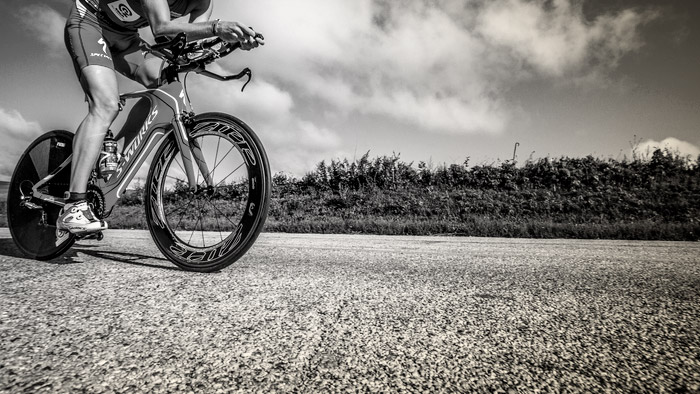The goal for fast triathlon riding is to stay in an aerodynamic position as much as possible, which means developing the physical ability and riding confidence to stay in your TT bars. Professional triathletes will tailor their training to adapt their back and body to be most efficient in that aero position, which they will maintain for the majority of the bike. Novice triathletes, on the other hand, can often be observed sitting up mid-ride—they’re giving up speed because they are less comfortable or confident in their aero position.
Riding in aero bars is a skill that we acquire early as triathlon cyclists, but it still requires practice. Here’s how you can develop your skills and confidence:
Riding Predictably
Predictable, straight-line riding is important. Not only is it more efficient, but it shows consideration to your fellow competitors and reduces your likelihood of causing an accident. Unfortunately, it’s not always easy, especially when you’re eating and drinking, starting your bike computer, grabbing water bottles on the course, or dealing with wind.
To get comfortable staying in your aero position through a variety of race-day situations, practice holding a stable line while executing the following skills:
- Reach behind you with one hand and then the other while maintaining your aero position. Touch the back of your seat; then progress to taking a water bottle out of a rear bottle cage.
- Reach down between your legs for a water bottle while pedaling, first seated upright and then in your aero position.
- Check over one shoulder and then the other without swerving.
- Go from base bars to aero bars and back to base bars without surging or wavering off your line.
- Go from aero bars to base bars and standing without accelerating or slowing.
- Try to keep your tires on a painted line on the road without swerving onto the pavement.
Have fun with these skills and practice regularly with a friend or teammate. You’ll quickly see your confidence and speed improve.
Cornering
Whether biking in a straight line or around a corner, staying in your aero bars is always faster than standing or sitting up. With practice, you can learn to maintain speed while cornering safely.
Find a quiet area with some 90-degree turns. An empty parking lot with some water bottles for markers is a great way to start. Once you’ve chosen or set up a corner, practice taking a wide arc through the turn at a low speed with the bike more upright. When you feel comfortable, reduce the arc of the turn by starting wide, riding tight through the apex and finishing wide again.
To practice cornering in your aero bars, go back to a slower speed and repeat the progression. You can also try cycling on a running track in your aero bars to get comfortable riding turns in a more controlled environment. You can take this same cornering progression into downhills by sitting up first, and then moving into the aero bars and tightening your line as you gain confidence. Make sure that you practice turning in both directions!
Climbing and Descending
Many athletes sit up too early into a climb—but it is beneficial to stay aero, as long as you are traveling faster than 12 to 15 mph. With experience you can look forward to a hill and anticipate the grade change, shifting to maintain a good cadence and constant pressure on the pedals. If you do sit up, remember to get right back into your aero bars as you crest the hill and accelerate.
To practice descending, start with a lesser grade and a clear braking path. Once you get comfortable with the lines, try pedaling in your aero bars. As you get more confident, try gradually steeper and more technical descents.
Just remember, some corners are too sharp to pedal and too extreme for aero bars—if you ever feel uncomfortable, err on the side of caution and ride in the position that feels most safe. As with all bike handling skills, always ride within your abilities and build a gradual progression for yourself; don’t take unnecessary risks.










